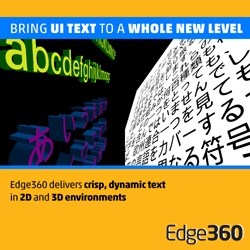Monotype Imaging Holdings (http://www.monotypeimaging.com), a provider of , an embedded solution for delivering text in 2D and 3D environments.
Supported by Monotype Imaging’s iType font engine version 5.0, also newly released, Edge360 works on devices such as smartphones and tablets that support OpenGL ES 2.0 hardware acceleration technology. A video demonstration of Edge360 is available at http://www.youtube.com/watch?v=0MAoMFJyZ50 .
“We’re opening unprecedented opportunities for enhancing user interfaces, applications and games,” says John Seguin, executive vice president of Monotype Imaging. “With Edge360, text can be zoomed in and out very quickly or rotated in three dimensions — all while retaining clarity throughout the process. Edge360 allows device manufacturers to integrate high-quality, movable text to achieve visually striking user experiences.”
Edge360 is an optionally licensed technology of iType 5.0, the newest release of Monotype Imaging’s scalable font engine that enables original equipment manufacturers and developers to build products that display sharp, highly readable text. OpenGL ES-compliant graphics processor units are required for devices using Edge360, which is able to take advantage of built-in GPU (graphics processor unit) acceleration to process 3D transformations and 3D text rendering in real time.
OpenGL ES is a royalty-free, cross-platform API (application programming interface) that supports full-function 2D and 3D graphics on embedded systems. It is managed by the Khronos Group, an industry consortium in which Monotype Imaging plays an active role to help shape open standards for fonts and multilingual text composition.
Edge360 leverages patented text rendering techniques of Monotype Imaging’s Edge Technology, which is supported by iType. Functions such as zoom and rotate, in addition to 3D text rendering and outline effects including “glow” may be handled in the GPU (graphics processing unit), freeing the main processor to complete other tasks. Text is able to appear smooth over a wide range of scale factors, without having to be re-rendered, for example, at the end of a zoom process, says Sequin. Original equipment manufacturers can also fine-tune rendered text output to meet unique device characteristics, he adds.


